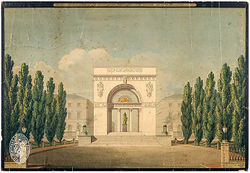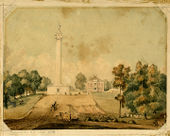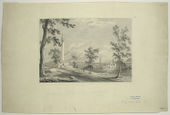Washington Monument (Baltimore, MD)
Overview
Site Dates: 1813–present
Site Owner(s): City of Baltimore (managed by the non-profit Mount Vernon Place Conservancy);
Associated People: Robert Mills, architect;
Location: Baltimore, MD · 39° 17' 56.83" N, 76° 36' 57.24" W
Condition: Extant
Keywords: Arch; Column/Pillar; Fence; Gate/Gateway; Promenade; Square; Statue; Walk; Yard
Other Resources: LOC; Getty TGN; Mount Vernon Place Conservancy;
The Washington Monument (Baltimore) is the centerpiece of an urban park with four radiating squares in the Mount Vernon neighborhood of Baltimore, Maryland. It is the earliest major commemorative structure planned in honor of George Washington (1732–1799), commander-in-chief of the Continental Army and first president of the United States. When completed, the 165-foot pedestal, column, and base constituted the tallest columnar structure in the world.[1] The monument’s fame attracted tourists, wealthy residents, and cultural institutions to Mount Vernon Place and initiated a wave of commemorative projects that led President John Quincy Adams (1767–1848) to dub Baltimore “The Monumental City” during a visit in 1827.[2]
History
In 1810 a group of Baltimore citizens began raising funds by lottery for a monument in Washington's honor. At the request of the managers of the Baltimore Washington Monument Society, the French architect Maximilian Godefroy (1765–c. 1838) submitted a variety of design possibilities, including an equestrian statue framed by a triumphal arch; a fountain within a rotunda; and a public square containing a statue of Washington surrounded by trophies.[3] None of these plans was adopted, and in 1813 the managers opened an international design competition that attracted entries from non-American artists, including the French neoclassical architect and landscape architect Joseph-Jacques Ramée (1764–1842) [Fig. 2]. The committee preferred not to give the commission to a foreigner, however, expressing the wish that “American artists will evince by their production that there will be no occasion to resort to any other country for a monument to the memory of their illustrious Fellow citizen.”[4]
In 1814 the committee awarded the commission to the American architect Robert Mills, who had drawn up a number of structurally and iconographically complex designs before settling on a massive pedestal resembling a Roman triumphal arch as the base for a 120-foot Doric column surmounted by a sculpture of Washington in a quadriga guided by a personification of Victory [Fig. 1]. Mills observed that the Doric proportions “possess solidity, and simplicity of character, emblematic of that of the illustrious personage to whose memory it is dedicated, and harmonising with the spirit of our Government” (view text). Despite his emphasis on simplicity, Mills devised an elaborate decorative scheme for the column and its base to reinforce the monument’s memorial and didactic functions. Six ironwork balconies were to divide the column at graduated intervals so that visitors climbing the internal stairway could pass outside to examine the bands of inscriptions and relief sculptures memorializing Washington's accomplishments and other events in America’s revolutionary history. A viewing platform at the top of the column would provide vistas of the surrounding scenery.[5] The monument was to be located on a summit to the north of the city on land that had been part of Belvedere, the estate of former Maryland governor and state senator, Col. John Eager Howard (1752–1827).[6]
Aesthetic concerns and lack of funding led to the radical simplification of Mills's design.[7] The monument ultimately took the form of an unadorned Doric column on a simple rectilinear base surmounted by a statue of Washington resigning his military commission to the President of the Maryland Congress. The Italian sculptor Enrico Causici (1790–1833) won the competition to create the 14-foot marble statue, which was set in place in 1829.[8] Many of the ornamental motifs that Mills had meticulously researched for the column and base were never added, despite his insistence that from a pedestrian’s perspective, they were “essentially requisite to give interest to the near view of the design, as without them there would be too great a degree of plain surface.”[9] From 1830 to 1838, Mills designed and oversaw the production of a cast-iron fence enclosure. It incorporated a number of symbolic elements originally intended for the monument, including distinctly Federal motifs such as stars, ribbon-bound fasces, and battle-axes.[10]
From the beginning, Mills was concerned with the relationship of the monument to its surroundings, and his attention to the viewer’s experience of the site as a whole resulted in the development of a larger park setting than originally planned. In his proposal, Mills had expressed the opinion that “Monuments isolated, or in the open air, should be towering, and commanding in their elevation, especially when they are encircled by a City, otherwise its popular intention is frustrated.”[11] The initial proposal included a description of the monument’s immediate surroundings, calling for a gravel walk, eleven feet wide, enclosed by a white picket fence in an octagonal configuration, with an ornamental shade tree at each angle.[12] In 1820 Mills reiterated his concern that “some place for a promenade for the public should be provided,”[13] and during the 1830s, as the land around the monument was being divided into house lots, he urged widening the streets leading to the monument as well as the circular green space surrounding the base. “It would be a pity to have the space about the Mon[umen]t cramped,” he wrote in 1836. “Ample room here will be found not only ornamental but useful for many purposes, for the parade of troops, for great public meetings, etc.” (view text).
A description published in 1848 documents many of the improvements requested by Mills and alludes to the undeveloped state of the four public squares that flanked the monument. The writer predicted: “When these spaces can be adorned with appropriate rows of trees, as well as embellished with marble fountains or basins, and other ornaments . . . it will become one of the most delightful promenades on this continent.”[14] Shade trees, shrubbery, sidewalks, and additional ornamental iron fencing in keeping with that designed by Mills were finally installed following passage of a city ordinance in 1850.[15]
—Robyn Asleson
Texts
- Mills, Robert, November 1813, initial proposal for the Washington Monument, Baltimore, MD (quoted in Hoyt 1939: 145–46)[16]
- “To the memory of General Washington, to be erected in the city of Baltimore, of octagonal form from the base to the top. . . .
- “From the base upwards to the first offset of the column eight feet, to be wrought at each angle the half of an octagonal pillar, cut diagonally nine inches diameter & both at the base and eight feet distant at the offset to be formed from angle to angle a cornice in the Tuscan order. . . .
- “The space or yard contiguous to the base of the column to be of diagonal 42 2/3 feet diameter, corresponding with the angles of the monument. . . .
- “On the Est, West, North and South of the monument to be placed two gate posts with a gate. Over the gate way to be suspended an elegant arch, consisting of white marble, the two ends resting on the to posts of each gate, bearing over the centre of each gate on the front of the arch the arms of the United States. All around the yard, which incloses the monument, to be formed a gravel walk, eleven feet in width, surrounded by an open fence of wooden posts and &railing, painted white with vacant spaces for entrance, opposite the gates.”
- Mills, Robert, 1814, formal statement of his plan for the Washington Monument, Baltimore, MD (quoted in Hoyt 1939: 154–55)[16]
- “In laying the designs herewith submitted, before you, I would beg leave to make a few remarks upon Monuments in general, before I proceed to describe the one I have the honor now to present.
- “The character that ought to designate all Monuments should be, solidity, simplicity, and that degree of cheerfulness which should tempt the contemplation of the mind. . . Monuments isolated, or in the open air, should be towering, and commanding in their elevation, especially when they are encircled by a City, otherwise its popular intention is frustrated. . . Permit me now to draw your attention to the description of the design in question:—The Mass, presents the appearance of a Greek Column, elevated on a grand pedestal; the column assumes the doric proportions, which possess solidity, and simplicity of character, emblematic of that of the illustrious personage to whose memory it is dedicated, and harmonising with the spirit of our Government. . .
- “Arrived at the platform which crowns this pedestal, and which is inclosed by a balustrade, we see the commencement of the great Column. The diameter of this is more than 20 feet and its elevation above 120 ft. divided in its heigh by Six iron railed galleries, which encircle it like bands, presenting promenades to accommodate the reading of those historical inscriptions recorded on the shaft of the column.” back up to History
- Mills, Robert, 1836, arguing to increase the area around the Washington Monument, Baltimore, MD (quoted in Lavoie 2005: 28)[17]
- “It would be a pity to have the space about the Mont [monument] cramped, after making the sacrifices that have been made—ample room here will be found not only ornamental but useful for many purposes, for the parade of troops, for great public meetings, etc.” back up to History
- Willis, Nathaniel Parker, 1840, American Scenery (1840: 2:92)[18]
- “This fine monument stands at the end of a long street, forming an ascending perspective; and it base crowns the summit of a considerable hill, it is fully relieved against the sky, and shows very nobly. The square which immediately surrounds it is newly divided into building-lots. . .
- “The monument is a Doric column upon a square base, surmounted by a pedestal, upon which is placed a colossal statue of Washington. The base is fifty feet square, and is elevated twenty feet; the column, to the feet of the statue, is one hundred and sixty feet, and the statue is thirteen feet in height. The statue is the work of Causici, an Italian, and represents Washington at the instant when he resigned his commission after the Revolution.” [Fig. 3]
Images
Notes
- ↑ Pamela Scott, “Robert Mills and American Monuments,” in Robert Mills, Architect, ed. John M. Bryan (Washington, DC: American Institute of Architects Press, 1989), 150, view on Zotero.
- ↑ Hezekiah Niles, “The President of the United States,” Niles’ Weekly Register 9, no. 8 (October 20, 1827): 114, view on Zotero.
- ↑ J. Jefferson Miller, “The Designs for the Washington Monument in Baltimore,” Journal of the Society of Architectural Historians 23 (1964): 19–21, view on Zotero.
- ↑ Rhodri Windsor Liscombe, Altogether American : Robert Mills, Architect and Engineer, 1781–1855 (New York: Oxford University Press, 1994), 63, view on Zotero.
- ↑ John M. Bryan, Robert Mills: America’s First Architect (Princeton, NJ: Princeton Architectural Press, 2001), 105–17, view on Zotero; Miller 1964, 22–27, view on Zotero; William D. Hoyt Jr., “Robert Mills and the Washington Monument in Baltimore” [Part One], Maryland Historical Magazine 34 (1939): 155–57, view on Zotero.
- ↑ Lance Humphries, “Baltimore and the City Beautiful: Carrère & Hastings Reshape an American City,” in Modernism and Landscape Architecture, 1890–1940, ed. Therese O’Malley and Joachim Wolschke-Bulmahn, Studies in the History of Art, Center for Advanced Studies in the Visual Arts, Symposium Papers, LV (Washington, DC: National Gallery of Art, 2015), 250, view on Zotero.
- ↑ Scott 1989, 146–54, view on Zotero.
- ↑ Bryan 2001, 208, 210–12, view on Zotero.
- ↑ Catherine C. Lavoie, Washington Monument, Mount Vernon Place (Baltimore: Historic American Buildings Survey, 2005), 13–14, view on Zotero.
- ↑ Robert L. Alexander, The Architecture of Maximilian Godefroy (Baltimore: Johns Hopkins University Press, 1974), 180–82, view on Zotero.
- ↑ Hoyt 1939, 154, view on Zotero.
- ↑ Hoyt 1939, 146, view on Zotero.
- ↑ Lavoie 2005, 27, view on Zotero.
- ↑ Lavoie 2005, 15, view on Zotero.
- ↑ Humphries 2015, 251, view on Zotero; Lavoie 2005, 29, view on Zotero.
- ↑ 16.0 16.1 Hoyt 1939, view on Zotero.
- ↑ Lavoie 2005, view on Zotero.
- ↑ Nathaniel Parker Willis, American Scenery, or Land, Lake and River Illustrations of Transatlantic Nature, 2 vols. (Barre, MA: Imprint Society, 1971), view on Zotero.








